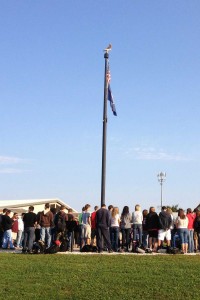 It was like training for an Olympic event. We got up early to practice. We had a strategy, a game plan and a captain. And then, on the morning of See You at the Pole, I always had butterflies in my stomach.
It was like training for an Olympic event. We got up early to practice. We had a strategy, a game plan and a captain. And then, on the morning of See You at the Pole, I always had butterflies in my stomach.
But it was a simple event: we’d just gather around our school’s flagpole before school, hold hands like only Christians do, and pray. We’d pray for our classmates, our teachers, our school, our government, and our nation. People who I had never heard pray out loud prayed out loud. And in the end, we all ate donuts and went to class as usual.
Sure, there were questions throughout the day. What were you guys doing out there this morning? Did we get a new flag? Did someone die? Were you protesting? Was it a vigil? And we all knew it wasn’t any of those things. It was just a group of students, gathered in public to pray for their community.
So this morning, as perhaps millions more students take their turn around the pole, here are a few of the lessons it taught me, and what I hope today’s students will learn too.
Prayer isn’t about proving something.
See You at the Pole is a prayer gathering, after all, not a protest. We never treated it as a protest, though sometimes there were others who protested against us. Our aim was simply to pray for the people we were closest to.
The Gospels warn against such public prayer, though, and is reason for caution and to check our hearts before we participate in events like these.
Matthew 6:5 says, “And when you pray, do not be like the hypocrites, for they love to pray standing in the synagogues and on the street corners to be seen by others. Truly I tell you, they have received their reward in full.”
The truth is, once-a-year-public-prayer, if it is not backed up by a life of prayer without ceasing does prove something: that those who stand on the street corner, or around the pole, are hypocrites just wanting to be noticed.
Prayer isn’t about who says the most.
Matthew 6:7 continues, “And when you pray, do not keep on babbling like pagans, for they think they will be heard because of their many words.”
Both this and the previous passage assumes we will pray, and we should. But sometimes I stand in a circle of prayer and listen to myself or someone else wander all around the block with flowery words and a myriad of ummh’s and I just want to’s and I have to wonder how much different our prayer is from the babbling pagans.
Instead, Philippians 4:6 offers a bit of advice, to simply “present your requests to God” by prayer and petition. One of the beautiful things about See You at the Pole when I was a student, was we had a plan. We knew what we wanted to pray for. We mapped out our requests. We listed the things we’d planned to bring before God. And then we presented them to him. There wasn’t time for babbling, because we all knew in a few minutes, the bell was going to ring.
Prayer brings the body of Christ together.
Mark 11:25 provides another warning, “And when you stand praying, if you hold anything against anyone, forgive them, so that your Father in heaven may forgive you your sins.” And I certainly remember standing around that pole and thinking the worst thoughts about my classmates hurrying along just inside that window, on their way to class. I know, I should have had my eyes closed, but I wanted to see who was seeing us.
What I missed, by gazing outside that circle, was who was in that circle. Kids that I didn’t know were Christians showed up to pray—apparently they attended other churches. And for that moment, that morning, we were all standing together in prayer for the one thing we all agreed on: that our classmates and teachers needed Jesus as much as we did.
So that’s my prayer this morning, as so many students are holding hands around their school’s flag pole, that they would not only lift up their schools in prayer, but that they would learn something too.
Did you participate in SYATP as a student? What did you learn from your experience?
For more information about See You at the Pole, visit http://nationaldayofprayer.org/see-you-at-the-pole or www.syatp.com.